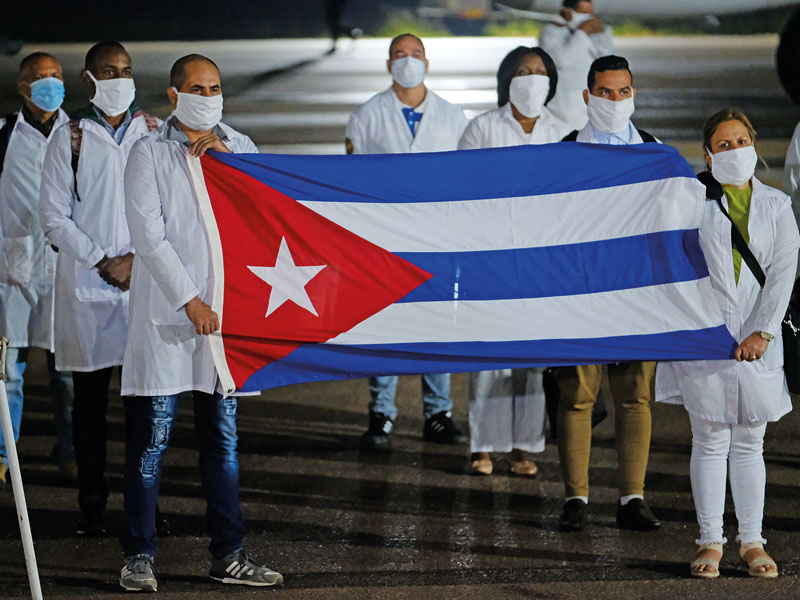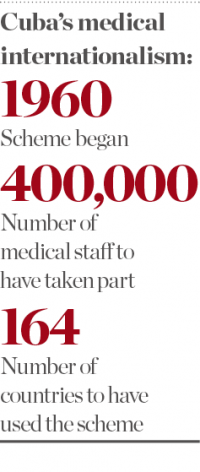
With globalisation making the world increasingly homogeneous, there are few unique places left to experience. Cuba, under one-party rule since 1959, is different – modernity seems not to have fully arrived in the country. Cars from the 1940s and 50s line the streets of Havana and well-known brands are conspicuously absent. But the impact of the country’s unique economic model extends beyond cultural quirks.
The island’s state-planned economy has at times struggled for growth, with US-imposed embargoes certainly not helping matters, but it also has some notable areas of strength. One of these is healthcare, with Cuba’s ratio of 8.2 physicians per 1,000 people standing as one of the highest in the world.
Cuba’s relative isolation seems to not have adversely affected the development of its health service
Not all of the country’s doctors are available to treat their fellow citizens at any one time, however, because a significant proportion of them are engaged in medical internationalism. The COVID-19 pandemic has reaffirmed the need for Cuba’s doctors abroad, and they have been sent to Italy, South Africa and Andorra, to name just a few countries. The decision to accept Cuba’s assistance has received both praise and criticism: some see the country’s help as evidence of the kind of cooperation needed in these difficult times, while others see it as a soft power move on the part of the socialist government.
In good health
While you might struggle to find a McDonald’s in Cuba – surprisingly, there is one, but it can only be accessed via a US naval base to the south-east of the country – you certainly won’t struggle to find a doctor or nurse. The country boasts around 95,000 doctors and 85,000 nurses as a result of a complete overhaul of the healthcare system in the 1960s.
“Cuba’s healthcare sector is very strong,” John Kirk, a professor of Latin American studies at Canada’s Dalhousie University, told European CEO. “Cuba has three times the patient-doctor ratio that the US has. Life expectancy is roughly the same as that of the US, but Cuba has better infant mortality rates and under-five mortality rates. Cuba’s healthcare is the best in the Global South. In February 2019, Cuba was ranked 30th among the world’s healthiest countries – the first among developing countries. The US was in 35th position.”
Cuba’s relative isolation seems to not have adversely affected the development of its health service. The country produces around 65 percent of its own medicines and even exports some sophisticated drugs, such as CIMAvax, a lung cancer vaccine that is currently undergoing clinical trials in Roswell Park Comprehensive Cancer Centre in Buffalo, New York. Unsurprisingly, Cuba’s healthcare has received praise from many quarters, with then UN Secretary-General Ban Ki-moon stating in 2014: “I want to join so many others in saluting Cuba’s healthcare system… A model for many countries around the world.”
Shift work
In addition to an enviable healthcare record at home, Cuba has been sending medical personnel abroad since 1960 – most of the time for altruistic reasons. In all, some 400,000 medical staff have worked in 164 countries. “Cuba has done remarkable things – without charging patients anything,” Kirk said. “Most significantly, the Operation Miracle ophthalmology programmes have undertaken almost four million eye surgeries on patients in Latin America and the Caribbean… 25,000 patients (mainly children from Ukraine) were treated in Havana for medical conditions as a result of the Chernobyl implosion, and Cuba has trained 29,000 doctors from developing countries at the Latin American [School of Medicine] in Havana.”

In 2005, Cuba formed the Henry Reeve International Medical Brigade to deliver aid to foreign states dealing with epidemics and disasters. As a result of the COVID-19 pandemic, the brigade has been deployed in various countries, many of which hadn’t had cause to receive medical help from the island before. In addition, Cuba sent specialist staff to 14 countries where the brigade was already present.
“The current coronavirus pandemic has increased demand for Cuban medical support,” Kirk said. “It is worth noting that, for the first time, European countries such as Italy (where there are Cuban medical brigades in Lombardy and Turin) and Andorra have requested emergency medical support from Cuba.”
Once COVID-19 retreats and life reaches some semblance of normality once more, the temporary hospitals that have been erected in Italy and other European countries will likely be dismantled. The Cuban doctors that helped to staff them will also leave, but the memory of the help they provided will remain, which creates brilliant publicity for a socialist government that has its fair share of detractors.

All is not well
Despite the seemingly altruistic efforts of Cuba’s doctors, not everyone is happy to accept their help – in particular, the country’s long-time nemesis, the US. Following Cuba’s deployment of healthcare professionals to countries struggling to contain the new coronavirus, the US Government, via its embassy in Havana, suggested that countries should not accept Cuba’s assistance because its government was simply “recovering the money lost by countries that abandoned this abusive programme”.
“There is another side to Cuba’s medical internationalism, for which it gets paid,” Kirk added. “Indeed, the exportation of medical services is the single largest source of hard currency for Cuba – some $6.8bn [€6.28bn] in 2018, and double the amount resulting from tourism. The Cuban hospital in Dukhan, Qatar, employs 500 Cuban medical personnel.” The government charges countries that use its services based on their ability to pay, Kirk added: “Poorer countries, such as Niger or Haiti, do not pay for medical services, whereas others, such as Portugal or South Africa, do pay for services.”
Certainly, as some governments in South America have taken on a more right-wing flavour, they have stopped paying for Cuba’s medical internationalism – most recently in Brazil, Bolivia and Ecuador. COVID-19, and the desperation with which nations are attempting to curtail the spread of the disease, could provide fertile ground for Cuba to negotiate new medical contracts abroad.
There is also evidence to support the view that Cuba’s doctors are exploited by the political regime at home. The Cuban Government retains about three quarters of the doctors’ pay, which remains a better deal than those practising at home receive, but which means much less money ends up in their pockets compared with the local doctors they are working alongside. There are also reports that Cuban officials are confiscating health workers’ passports and a portion of their payment until they have returned home, although the Cuban Government has denied these claims.
The US deems Cuba’s international medical programme as a form of human trafficking and has offered residency to those involved. Between 2006 and 2016, more than 7,000 Cuban doctors escaped to start a new life within the borders of their capitalist neighbour. Such departures create a much shadier image of the programme than the one painted by the Cuban Government.
Public relations aside, the work of Cuba’s travelling doctors will certainly be appreciated by the nations that have received their support during the coronavirus pandemic. But it is also true that any money the scheme brings in will probably do more good for the national government than for the doctors themselves.

